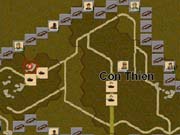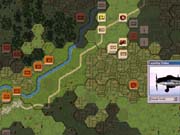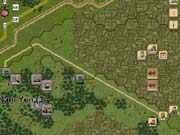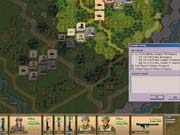HPS Simulations' Squad Battles: Vietnam is the latest wargame from one of our most talented wargame designers, John Tiller. As such, it doesn't quite live up to what it should be. There are parts of the game that have an unpolished feel, as if this were the work of someone new to the business. But overall, it's a refreshingly visceral wargame set in a conflict that other designers have shied away from.

It's hardly surprising that there haven't been many wargames set in Vietnam. It was a conflict without the clarity of the American Civil War or World War II. The dynamic wasn't so much the division-to-division clashes of conventional wars. Instead, it was the firepower of the United States pitted against the determination of the Communist Vietnamese. The lines of battle were blurred. The fighting was so mobile that there was no real front. The enemy lurked in the jungle and took shelter among civilian populations. There's an argument to be made that this wasn't even a war. So how do you approach the subject matter in a wargame?
The answer is, "you zoom in." As you might guess from its name, Squad Battles: Vietnam is intimately tactical. It presents the Vietnam conflict as a series of close encounters fought primarily with small arms. While the basic look and feel are similar to those of Tiller's Campaign Series for TalonSoft (East Front, West Front, Rising Sun, and Divided Ground), the gameplay is different for a number of reasons.
The scale is the most immediate difference. The Campaign Series played out with platoon-sized units (approximately 50 men) moving across 250-meter hexes, but Vietnam uses squad-level units (approximately 10 men) moving across 40-meter hexes. In the Campaign Series, units have an abstract strength value, but in Squad Battles, individual soldiers and guns are tracked. An infantry unit consists of a specific number of men and the things they carry. It feels concrete and personal. A marker isn't just a bunch of numbers, it's men and the weapons cradled in their arms.
Every man and weapon is given an effectiveness rating that's represented by a percentage. Your men become less effective under fire, and so do their weapons. Guns break, jam, and run out of ammo. The percentages make this accessible. Here are 10 men with M16s, a few grenade launchers, and an M60 light machine gun, all functioning at 100 percent. Then they're under fire. They take a few casualties. Suddenly you've only got eight men functioning at 75 percent. The light machine gun is gone and the M16s are down to 85 percent. It all feels much more immediate than trafficking in strength points or firing values.

In keeping with the personal feel of the game, there's a strong sense that artillery and air strikes are off-site forces tenuously connected by radio contact and command structure. To call them in, you need a leader and a radio, which is usually being humped by an RTO, or radio/telephone operator. Even then, it takes precious minutes between the call for support and its arrival. The amount of time is randomly determined (something that Squad Battles should have done with the arrival of reinforcements). When support arrives, you'll want your leader to be able to trace a line of sight to the target, which can be dangerous. It's not a simple matter of opening a dialogue box and selecting a target. Squad Battles leaves you waiting and vulnerable while you hold out for the aircraft or artillery shells to arrive. It adds a welcome new level of tension to the gameplay.
Helicopters, which really came into their own during this era, are similarly handled. Helicopters are as vulnerable as they are powerful. Their speed and firepower can tilt the balance of a battle, but you have to use them carefully. Because Squad Battles models the difference between hovering as an easy target and making high-speed passes, you have to keep your helicopters moving. But when you're flying in troops, you have to bring your helicopters into a hover and land them. You'll want to use firepower to suppress any enemy positions before you touch down, which also adds tension. The situation with armor is similar. The terrain in Vietnam rarely allowed armor to fire from a safe distance. So inching your tanks forward when there could be recoilless rifles and antitank rockets in the nearest rice paddies is a nerve-wracking experience. When playing as the US, Squad Battles is a wargame about putting men and their powerful but frail toys in harm's way.
Battles also play out very differently than in Tiller's Campaign Series wargames. This isn't a matter of just spending action points to run around. It isn't dashing from hedgerow to hedgerow or charging machine gun nests. Each battle tends to split into two phases. The first phase consists of carefully advancing on a position. Once you make contact and the firing starts, the second phase begins. From then on, all your men are crawling on their bellies and the game is no longer about movement. Instead, it's all about concentrating firepower. In this respect, the game feels very much like a turn-based version of Atomic's Close Combat series, which drove home the point that pinning a man under fire and breaking his morale is just as effective as killing him outright.

Although Squad Battles has its share of "chess puzzles"--hard-coded situations in which you have to figure out the solution--it also has plenty of meaty, flexible scenarios that represent wargaming at its best. Scenarios like Con Thien, LZ Blue, and Ap Chinh An afford a lot of mobility and, therefore, a wide range of choices for how to play. "Here's a vast map, here's a lot of men, here are your objectives," says Squad Battles. "Now let's see what you can do." There's no ongoing campaign here, but there are battles represented as a series of scenarios. There are also scenarios with alternate setups that give them some replay value.
The basic engine has some shortcomings that are surprising coming from someone with Tiller's experience. As in his Campaign Series, moving units is a matter of either guesstimation or tedious calculation. The game doesn't show movement costs until you commit to moving a unit. If you want to be precise--and of course you do, since this is a wargame--you'll have to look up various tables and do some math. This isn't a huge problem once you're familiar with the system, but this is the sort of thing that the computer should do for you. It would certainly have made the game easier for new players. This has been a shortcoming in Tiller's games all along.
What's more surprising is the way Squad Battles completely ignores the importance of enfilade (from the flank) fire or being attacked from the rear or multiple directions. These are fundamental elements of combat that are nowhere to be found in Squad Battles: Vietnam. Without them, the game partly undermines its attempts at realism. There are rules to take into account morale, command, armor penetration, fatigue, cover, range, and so forth. So why would Tiller omit one of the most crucial aspects of a firefight--namely, the direction the bullets are coming from?

Finally, Vietnam should have offered more information. The Campaign Series allowed for detailed reports on the effects of each shot. Seeing the numbers laid out was a helpful way to learn the system. You could easily quantify how dangerous it was to be caught in the open, how powerful certain weapons were, and when you were outgunned. But in Vietnam, all this is under the hood. Tracer graphics give a rough estimate of how effective an attack is, and casualties are displayed using little explosion symbols. Perhaps Tiller wants to re-create the uncertainty of combat, but it would have been helpful to have more options. Also, the way the units are displayed on the map isn't always helpful. Short of manually clicking on every unit, there's no way to see which units are disrupted, whether a squad is depleted or at full strength, or where your leaders are. Also, the lack of control over opportunity fire during the other player's turn is too easily exploitable. You'll find yourself using distant units to draw your enemy's opportunity fire while it's ineffective. Then, once it's been spent, you can move closer units with impunity. This is one of the shortcomings in the artificial intelligence that should have been addressed.
If you'll forgive the reference, these problems keep Squad Battles from being all it can be. It's still a superlative wargame, but it's not Tiller's best. It is, however, perhaps his most accessible. Because of this, Squad Battles: Vietnam is another feather in his cap and the promising debut of what looks like an exciting new series.